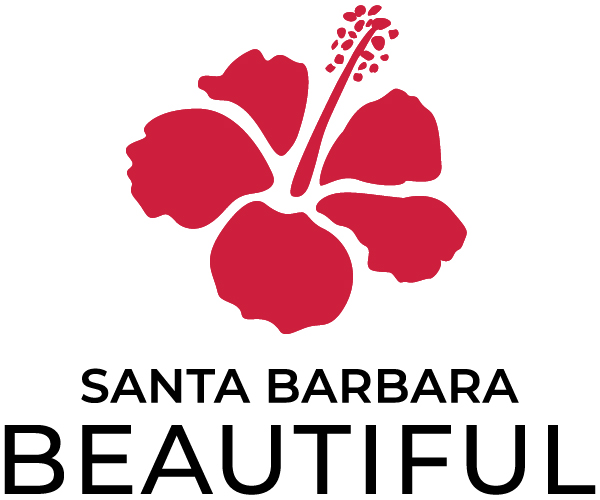
Tree-of-the-Month, August 2023
Primrose Tree
Lagunaria patersonia
In midsummer, when glorious Hibiscus-like flowers cover its canopy, the Primrose Tree provides a dazzling floral display that captures the attention. The rest of the year, its appearance is fairly ordinary – consequently, it is then largely overlooked.
Primrose Tree has been planted in Santa Barbara since the late 1800s; in 1895, pioneering horticulturist Dr. Francesco Franceschi noted it as a rather common tree. Originally endemic to small populations on Norfolk Island, Lord Howe Island, eastern Australia, and the North Island of New Zealand, it is now planted in many of the frost-free areas around the world.
Due to its varied origins and wide range of further cultivation, it has been given many common names in addition to “Primrose Tree”: “Norfolk Island Hibiscus”; “Queensland Hibiscus”; “Queensland White Oak”; “Pyramid Tree”; and, notably, “Cow-Itch Tree”.
This is a fast-growing, medium-sized, evergreen tree that normally reaches 20- to 30-feet (occasionally over 50-feet) in height, with a spread of 15- to 30-feet. It has a single, straight trunk. When young, its shape is symmetrical and pyramidal; as it matures, this will spread and become more open at the top.
The leathery oval-shaped leaves (2- to 4-inches long and ½- to 1-inch wide) are gray on top, gray-green and densely scaly underneath. The bark is light gray and smooth when young, turning dark gray with distinctive furrows with age. Without flowers, the tree is an attractive but otherwise typical shade tree.
The delightful, 5-petaled, single flowers (1 to 2 inches across) resemble miniature Hibiscus flowers. When freshly blooming, the petals are mauve, magenta, or pink in color; over time, they fade to light pink. A bright orange to gold colored column of long stamens (male parts) protrudes from the flower center. Like Hibiscus flowers, each flower is “perfect”, meaning it contains both female parts and male parts. A great variety of insect pollinators and hummingbirds are attracted by the abundant pollen and nectar.
Pollinated flowers produce fuzzy, green, five-segmented, fruit capsules (1½- to 2-inches long and 1- inch wide). When ripe, the capsules turn beige to dark brown, then split open to release reddish-brown, kidney-shaped seeds (¼-inch long). Caveat: surrounding the seeds are fine, white, sharp, fiberglass-like hairs that will cause a stinging skin irritation; they are the basis for the warning implied in the common name of “Cow-Itch Tree” (not a reference to bovines – the name is actually a corruption of the word “cowage”, a local name in India). Some capsules can remain on the tree for several growing seasons before dropping off.
Not surprisingly, Primrose Tree is in the Malvaceae plant family, which also holds Mallow and Hibiscus. However, it is the only species in its genus. The genus name, Lagunaria, honors the Spanish botanist and doctor Andres Laguna de Segovia (1494-1560). The specific epithet, patersonia (formerly patersonii), honors Colonel William Paterson (1755-1810), a Scottish soldier and amateur botanist who was stationed in Australia beginning in 1791 and was Lieutenant Governor of New South Wales from 1880 to 1810 – in 1792, he first sent seeds of this tree to England.
Primrose Tree prefers a location with full sun but can tolerate partial shade. It has no serious insect or disease problems; however, it is susceptible to phytophthora root fungus, so it should be planted in well-drained soil – it can grow in poor soils, but not in heavy clay. When young, it does require irrigation; once established, it is drought tolerant. It should be planted in frost-free areas, though it will tolerate brief temperatures down to 25 degrees F. It is easy to propagate from seeds. It is a low-maintenance tree that requires little pruning; however, it tends to grow sprouts and foliage low on the trunk – these can be easily removed.
The wood is white and smooth-grained, so it has been used for construction and furniture. That said, its primary value is for use as an ornamental tree. It is versatile and responds well to training, so it can be maintained as a tree for small or narrow spaces. The primary consideration must be the irritating hairs in its seed pods – it is best to plant it in areas away from heavy human activity. Even with that limitation, it makes a lovely specimen tree in parks and private gardens – or can be used as a screen or hedge.
Primrose Trees can be seen in several locations in our community: as street trees, on Corona Del Mar; a large tree in the 1200 block of Santa Barbara Street (by the County Administration parking lot); in the first block of W. Yanonali Street (across from the railroad depot); in the 300 and 400 blocks of E. Gutierrez Street; in the 900 block of E. Carpinteria Street; at 1719 Chino Street; also, as specimen trees, in Shoreline Park(6 trees at the west end) and in Goleta at both the Stow House and the Sexton Inn (2 trees).
Article and Photos by David Gress



